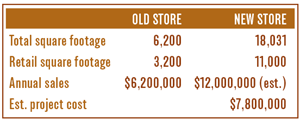Becoming a Community Hub

The growth of BriarPatch Co-op (Grass Valley, Cal.), founded in 1976, has been marked by four expansions. From 1992 until May 2007, we occupied a 3,200- square-foot store. Annual sales there had increased to $6.2 million, and we were bursting at the seams.
When we looked for a larger facility, there were no existing buildings available that suited our needs. We started talking with developers about a new building. Eventually we hooked up with Calloway Development, owned by a local family that was interested in developing a natural foods store across the street from the local high school and the community college and in the vicinity of several large medical and legal office buildings. This location was only half a mile from our current store. While we didn’t feel that we could afford to own the building from the start, we secured an option in our new lease to purchase the building after three years.
Early in the new store planning process, we created a design committee made up of directors, managers, and a couple of other owners. One of the first decisions made by this committee was to work toward making our new store a green building. After much research, BriarPatch and our developer decided to build a LEED-certified building following the methodology of the U.S. Green Building Association. The reason to make our new store a green building was twofold: to walk our talk as an environmentally sound business and to educate our community about the benefits of a green construction.
Our design committee also decided early in the process that we wanted the new BriarPatch Co-op to be more than just a store—we wanted it to be a community hub. With this is mind, we designed a patio in front of the building with a large seating area, an indoor area that can seat 50 people, and a “community room” for use in our educational activities as well as for other community functions. These aspects of the store have been a huge success, and I believe they have been key to doubling our sales almost immediately upon relocating.
One of the biggest challenges was to develop a large deli. Our old store had a four-foot counter where we made sandwiches. In surveying our owners, it was clear that they wanted a significantly larger deli with a full line of food. We also knew that this would be a key to bringing in the new customers that we would need to support a larger store.
We hired Allen Seidner of Thought for Food Consulting to help us design and develop our new foodservice department and to work with our new deli manager, Chris Maher, to train an opening staff of 45 people. With clarity about our full potential as foodservice providers and Allen’s encouragement, we boldly allocated significant space and monies to accommodate his design, which includes a gorgeous custom-built hot and cold food bar, a hot grill sandwich station, rotisserie chickens, and full beverage bar. We are on track to do over $2,000,000 in foodservice sales in our first year, and our food is the talk of our town. Our community sorely lacked an organic and natural food deli, and the success of this department has helped bring in lots of new customers. Foodservice is a huge part of our becoming the community hub we envisioned.
We also added a full-service meat department, one of the other areas that our owners strongly wanted in the new store. This has been another draw for new shoppers. One of the comments we often got in our old store was that the only reason our shoppers needed to go to other stores was to buy meat.
Besides adding the deli and meat departments, we increased the offerings in existing departments by anywhere from 50 to 100 percent. All of our department managers have stepped up to the challenge and are developing new systems to handle the new, larger volumes.
The building process took a year and a half of planning plus nine months of construction. One of the blessings of this project was that we had a fantastic team. Our architect Jeff Gold, general contractor Tru-Line Builders, and the developer all worked extremely well with BriarPatch to create the plan and budget for the project. The entire project went relatively smoothly—we opened the store only two weeks later than our initially scheduled date and $100,000 under budget.
On the eve of officially opening the store, we had a “preview night” for our owners. The turnout was overwhelming. Despite being in our new larger store, you could hardly move because there were so many people. We took in over $16,000 in sales that night in just two and a half hours. Our owners were extremely pleased and have become one of our best marketing tools.
Now, two months later, we are still working out the kinks and developing new systems. We have increased our staff from 70 to 146. I know that it will take at least a few months to adapt to all of the changes. As many managers who have undergone this kind of growth have told me, now is when the real work begins.
***
Paul Harton is general manager at BriarPatch Co-op in Grass Valley, California (paul@briarpatch.coop).







